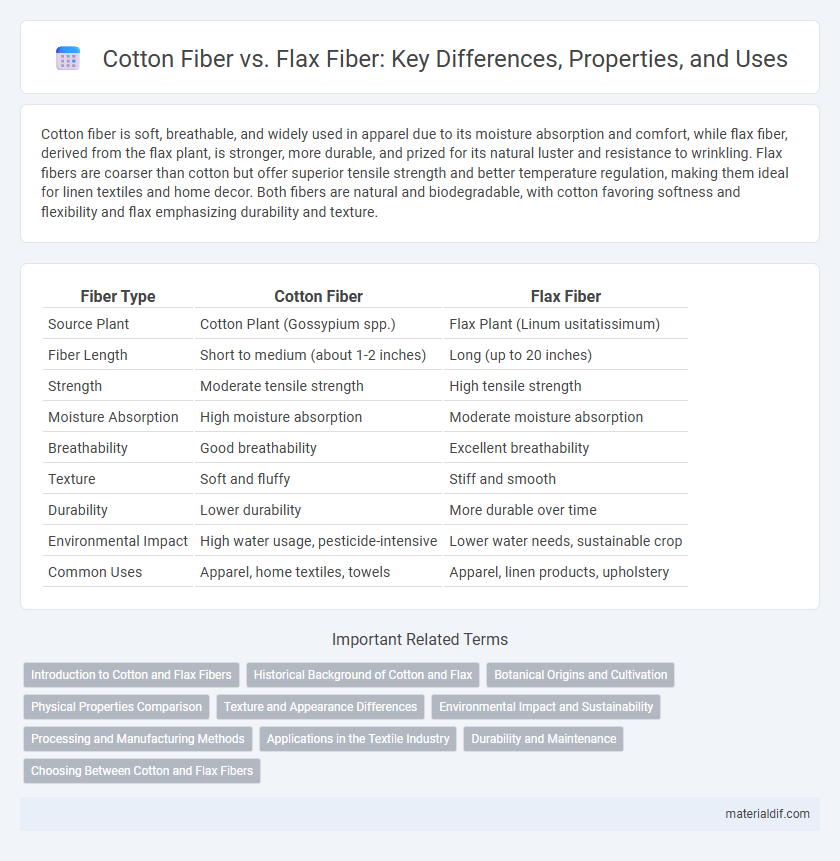Cotton fiber is soft, breathable, and widely used in apparel due to its moisture absorption and comfort, while flax fiber, derived from the flax plant, is stronger, more durable, and prized for its natural luster and resistance to wrinkling. Flax fibers are coarser than cotton but offer superior tensile strength and better temperature regulation, making them ideal for linen textiles and home decor. Both fibers are natural and biodegradable, with cotton favoring softness and flexibility and flax emphasizing durability and texture.
Table of Comparison
| Fiber Type | Cotton Fiber | Flax Fiber |
|---|---|---|
| Source Plant | Cotton Plant (Gossypium spp.) | Flax Plant (Linum usitatissimum) |
| Fiber Length | Short to medium (about 1-2 inches) | Long (up to 20 inches) |
| Strength | Moderate tensile strength | High tensile strength |
| Moisture Absorption | High moisture absorption | Moderate moisture absorption |
| Breathability | Good breathability | Excellent breathability |
| Texture | Soft and fluffy | Stiff and smooth |
| Durability | Lower durability | More durable over time |
| Environmental Impact | High water usage, pesticide-intensive | Lower water needs, sustainable crop |
| Common Uses | Apparel, home textiles, towels | Apparel, linen products, upholstery |
Introduction to Cotton and Flax Fibers
Cotton fiber, derived from the seed hairs of the Gossypium plant, is renowned for its softness, breathability, and versatility in textile production. Flax fiber, obtained from the stalks of the Linum usitatissimum plant, is valued for its strength, durability, and natural luster, primarily used in producing linen fabrics. Both fibers are natural cellulose-based materials but differ significantly in texture, processing methods, and end-use applications.
Historical Background of Cotton and Flax
Cotton fiber, originating around 5000 BCE in the Indus Valley, played a crucial role in ancient textile development and global trade, especially influencing economies in Egypt and the Americas. Flax fiber, dating back over 10,000 years to the Neolithic era in the Fertile Crescent, was primarily used for linen production and held significant cultural importance in ancient Egypt, symbolizing purity and durability. Both fibers shaped early civilizations by providing essential materials for clothing, trade, and technology, with flax often associated with finer, durable textiles and cotton favored for its softness and versatility.
Botanical Origins and Cultivation
Cotton fiber originates from the seed hairs of the Gossypium plant, primarily grown in tropical and subtropical regions with warm climates and well-distributed rainfall. Flax fiber is derived from the stems of the Linum usitatissimum plant, cultivated mainly in cooler temperate zones with well-drained soils. Cotton cultivation demands higher water input and longer growing seasons, whereas flax requires less water and thrives in more temperate, humid environments.
Physical Properties Comparison
Cotton fiber exhibits shorter staple length, higher moisture absorption, and softer texture compared to flax fiber, which has longer, coarser, and stronger fibers with greater tensile strength. Flax fibers demonstrate higher luster and better thermal conductivity, making them ideal for durable, breathable textiles, whereas cotton fibers provide superior comfort and flexibility. In terms of density, flax fibers are heavier and stiffer, contributing to enhanced durability but less elasticity than cotton.
Texture and Appearance Differences
Cotton fiber features a soft, fluffy texture with a matte finish, making fabrics smooth and breathable, while flax fiber exhibits a coarser, more rigid texture with a natural sheen that adds a crisp, lustrous appearance to linen fabrics. Cotton fibers are shorter and curlier, resulting in a plush, flexible fabric, whereas flax fibers are longer and straighter, producing a stiffer, more structured textile. These distinct textural qualities impact the drape and durability, with flax providing a stronger, more textured fabric compared to the gentle softness and pliability of cotton.
Environmental Impact and Sustainability
Cotton fiber cultivation demands extensive water usage and heavy pesticide application, contributing to significant environmental strain and soil degradation. Flax fiber production, by contrast, requires less water and fewer chemicals, making it a more sustainable option with lower ecological footprints. Additionally, flax fibers are biodegradable and renewable, enhancing their environmental benefits over cotton in sustainable textile manufacturing.
Processing and Manufacturing Methods
Cotton fiber processing involves ginning to remove seeds, followed by carding and spinning to produce soft, breathable textiles ideal for apparel. Flax fiber processing requires retting, which uses moisture or chemicals to separate fibers from the stalk, then scutching and hackling to refine fibers into long, blonde strands suited for durable linen fabrics. Manufacturing flax demands more labor-intensive steps compared to cotton, impacting overall production efficiency and fiber texture.
Applications in the Textile Industry
Cotton fiber is widely used in textile manufacturing for soft, breathable clothing such as T-shirts, underwear, and denim due to its excellent moisture absorption and comfort properties. Flax fiber, derived from the flax plant, is primarily utilized in producing linen fabrics known for their strength, durability, and natural luster, making it ideal for home textiles and high-end apparel. The textile industry favors cotton for everyday wear while flax is preferred for specialty textiles that require a more rigid, textured finish.
Durability and Maintenance
Cotton fiber offers moderate durability with a tendency to wear down after frequent washing, requiring gentle care to maintain softness. Flax fiber, derived from the flax plant, exhibits superior durability due to its natural strength and resistance to pilling, making it ideal for long-lasting textiles. Maintenance of flax fiber is relatively easy, as it withstands higher washing temperatures and is less prone to shrinking compared to cotton.
Choosing Between Cotton and Flax Fibers
Cotton fibers, known for their softness, breathability, and moisture absorption, are ideal for everyday wear and casual textiles. Flax fibers, derived from the flax plant, offer superior strength, durability, and natural luster, making them suitable for high-quality linens and eco-friendly fabrics. When choosing between cotton and flax fibers, consider factors such as comfort, environmental impact, and the intended use of the fabric to ensure optimal performance and sustainability.
Cotton Fiber vs Flax Fiber Infographic

 materialdif.com
materialdif.com